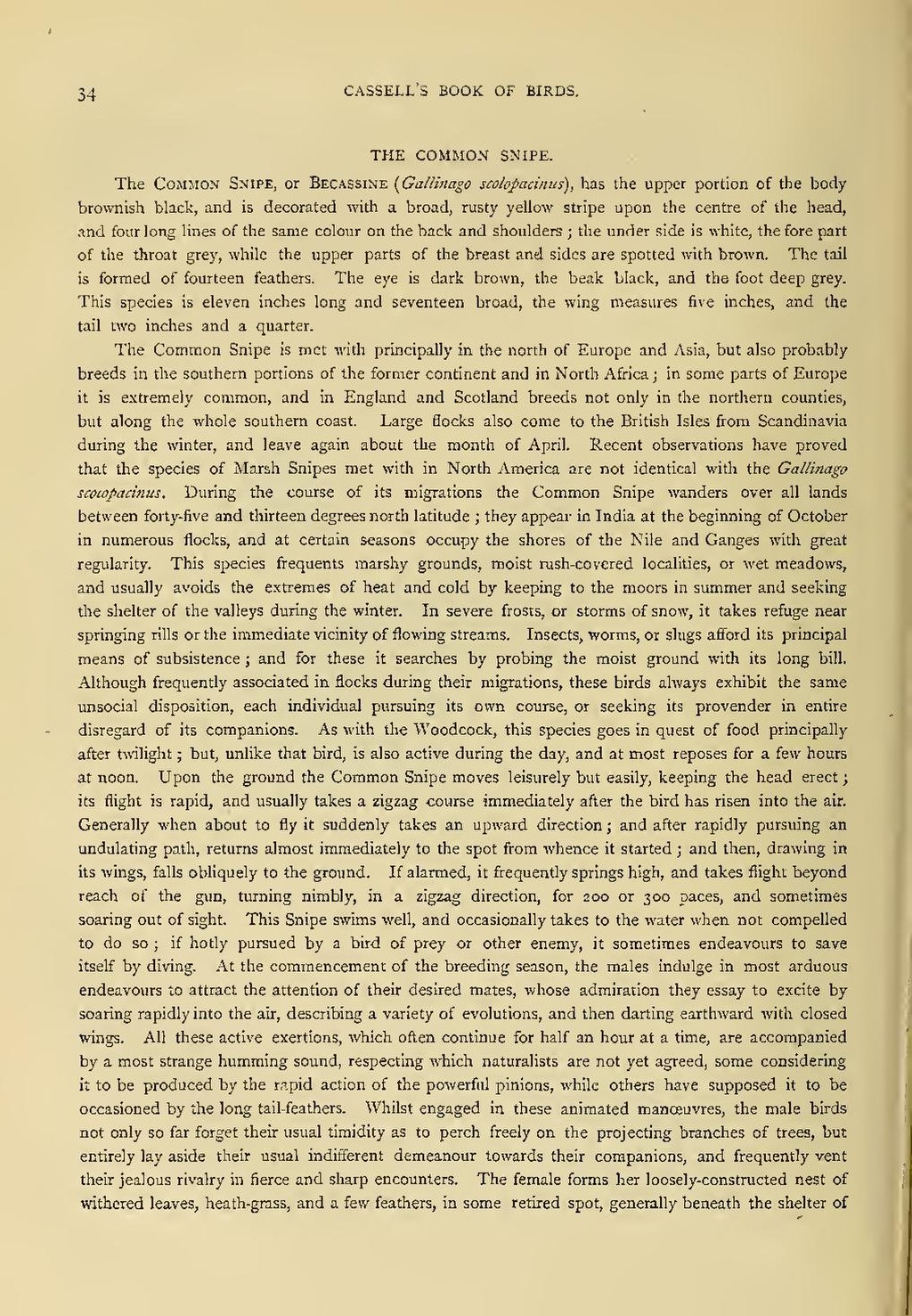THE COMMON SNIPE.
The Common Snipe, or Becassine (Gallinago scolopacinus), has the upper portion of the body brownish black, and is decorated with a broad, rusty yellow stripe upon the centre of the head, and four long lines of the same colour on the back and shoulders; the under side is white, the fore part of the throat grey, while the upper parts of the breast and sides are spotted with brown. The tail is formed of fourteen feathers. The eye is dark brown, the beak black, and the foot deep grey. This species is eleven inches long and seventeen broad, the wing measures five inches, and the tail two inches and a quarter.
The Common Snipe is met with principally in the north of Europe and Asia, but also probably breeds in the southern portions of the former continent and in North Africa; in some parts of Europe it is extremely common, and in England and Scotland breeds not only in the northern counties, but along the whole southern coast. Large flocks also come to the British Isles from Scandinavia during the winter, and leave again about the month of April. Recent observations have proved that the species of Marsh Snipes met with in North America are not identical with the Gallinago scotopacinus. During the course of its migrations the Common Snipe wanders over all lands between forty-five and thirteen degrees north latitude; they appear in India at the beginning of October in numerous flocks, and at certain seasons occupy the shores of the Nile and Ganges with great regularity. This species frequents marshy grounds, moist rush-covered localities, or wet meadows, and usually avoids the extremes of heat and cold by keeping to the moors in summer and seeking the shelter of the valleys during the winter. In severe frosts, or storms of snow, it takes refuge near springing rills or the immediate vicinity of flowing streams. Insects, worms, or slugs afford its principal means of subsistence; and for these it searches by probing the moist ground with its long bill. Although frequently associated in flocks during their migrations, these birds always exhibit the same unsocial disposition, each individual pursuing its own course, or seeking its provender in entire disregard of its companions. As with the Woodcock, this species goes in quest of food principally after twilight; but, unlike that bird, is also active during the day, and at most reposes for a few hours at noon. Upon the ground the Common Snipe moves leisurely but easily, keeping the head erect; its flight is rapid, and usually takes a zigzag course immediately after the bird has risen into the air. Generally when about to fly it suddenly takes an upward direction; and after rapidly pursuing an undulating path, returns almost immediately to the spot from whence it started; and then, drawing in its wings, falls obliquely to the ground. If alarmed, it frequently springs high, and takes flight beyond reach of the gun, turning nimbly, in a zigzag direction, for 200 or 300 paces, and sometimes soaring out of sight. This Snipe swims well, and occasionally takes to the water when not compelled to do so; if hotly pursued by a bird of prey or other enemy, it sometimes endeavours to save itself by diving. At the commencement of the breeding season, the males indulge in most arduous endeavours to attract the attention of their desired mates, whose admiration they essay to excite by soaring rapidly into the air, describing a variety of evolutions, and then darting earthward with closed wings. All these active exertions, which often continue for half an hour at a time, are accompanied by a most strange humming sound, respecting which naturalists are not yet agreed, some considering it to be produced by the rapid action of the powerful pinions, while others have supposed it to be occasioned by the long tail-feathers. Whilst engaged in these animated manœuvres, the male birds not only so far forget their usual timidity as to perch freely on the projecting branches of trees, but entirely lay aside their usual indifferent demeanour towards their companions, and frequently vent their jealous rivalry in fierce and sharp encounters. The female forms her loosely-constructed nest of withered leaves, heath-grass, and a few feathers, in some retired spot, generally beneath the shelter of
